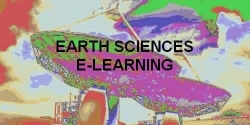E-Learning - The Earth and Beyond
E-Learning - The Earth and Beyond
back to Contents of the Entire Course...
Geology, What is it?
Why Study the Earth?
Earth Materials and
Processes
Principle of
Uniformitarianism
Energy Heat Transfer
Geothermal Gradient
The Earth -- What is it?
Internal Structure of the
Earth
Surface Features of the Earth
Plate Tectonics
adapted to HTML from lecture notes of Prof. Stephen A. Nelson Tulane University
Geology, What is it?
Geology is the study of the Earth. It includes not only the surface process which have shaped the earth's surface, but the study of the ocean floors, and the interior of the Earth. It is not only the study of the Earth as we see it today, but the history of the Earth as it has evolved to its present condition.
- Important point: The Earth has evolved (changed) throughout its history, and will continue to evolve.
- The Earth is about 4.6 billion years old, human beings have been around for only the past 2 million years.
- Thus, mankind has been witness to only 0.043% of Earth history.
- The first multi-celled organisms appeared about 700 million years ago.
Thus, organisms have only been witness to about 15% of Earth's history. Thus, for us to have an understanding of the earth upon which we live, we must look at processes and structures that occur today, and interpret what must have happened in the past. One of the major difficulties we have is with the time scale. Try to imagine 1 million years-- That's 50,000 times longer than most of you have lived. It seems like a long time doesn't it? Yet, to geologists, 1 million years is a relatively short period of time. More discussion about time in later lectures. But one thing we have to remember when studying the earth is that things that seem like they take a long time to us, may take only a short time to earth.
Examples:
- A river deposits about 1mm of sediment (mud) each year. How thick is the mud after 100 years? -- 10 cm hardly noticeable over your lifetime.
- What if the river keeps depositing that same 1 mm/yr for 10 million years? Answer 10,000 meters
Why Study the Earth?
- We're part of it. Dust to Dust. Humans have the capability to make rapid changes. All construction from houses to roads to dams are effected by the Earth, and thus require some geologic knowledge. All life depends on the Earth for food and nourishment. The Earth is there everyday of our lives.
- Energy and Mineral resources that we depend on for our lifestyle come from the Earth. At present no other source is available.
- Geologic Hazards -- Earthquakes, volcanic eruptions, hurricanes / cyclones, landslides, could affect us at any time. A better understanding of the Earth is necessary to prepare for these eventualities.
- Curiosity-- We have a better understanding of things happening around us. Science in general. I'll try to relate geology (and science in general) to our everyday lives.
Earth Materials and Processes
The materials that make up the Earth are mainly rocks (including soil, sand, silt, dust) . Rocks in turn are composed of minerals. Minerals are composed of atoms, Processes range from those that occur rapidly to those that occur slowly
- Examples of slow processes
- Formation of rocks
- Chemical breakdown of rock to form soil (weathering)
- Chemical cementation of sand grains together to form rock (diagenesis)
- Recrystallization to rock to form a different rock (metamorphism)
- Construction of mountain ranges (tectonism)
- Erosion of mountain ranges
- Examples of faster processes
- Beach erosion during a storm.
- Construction of a volcanic cone
- Landslides (avalanches)
- Dust Storms
- mudflows
- Hydrologic Cycle
- Rain comes from clouds - falls on surface, picks up sand, silt and clay, carries particles to river and into ocean. Water then evaporates to become clouds, which move over continents to rain again.
- Rock Cycle
- Rates -- rates of processes may change over time for example a river might deposit 1 mm of sediment /yr at if we look at it today. but, a storm could produce higher runoff and carry more sediment tomorrow. Another example: the internal heat of the Earth may have been greater in the past than in the present -- rates of processes that depend on the amount of heat available may have changed through time.
- Observations -- we may not have observed in human history all possible processes. Mt. St. Helens Example. Size of Earthquakes example.
- Gravitational energy -- Energy released when an object falls from higher elevations to lower elevations.
- Heat energy -- Energy exhibited by moving atoms, the more heat energy an object has, the higher its temperature.
- Chemical Energy -- Energy released by breaking or forming chemical bonds.
- Radiant Energy -- Energy carried by electromagnetic waves (light). Most of the Sun's energy reaches the Earth in this form.
- Atomic Energy -- Energy stored or released in binding of atoms together. Most of the energy generated within the Earth comes from this source.
- Conduction - atoms vibrate against each other and these vibrations move from high temperature areas (rapid vibrations) to low temperature areas (slower vibrations).- Heat from Earth's interior moves through the solid crust by this mode of heat transfer.
- Convection - Heat moves with the material, thus the material must be able to move. The mantle of the Earth appears to transfer heat by this method, and heat is transferred in the atmosphere by this mode.
- Radiation - Heat moves with electromagnetic radiation (light) Heat from the Sun or from a fire is transferred by this mode
- Crust - variable thickness and composition
- Continental 10 - 50 km thick
- Oceanic 8 - 10 km thick
- Mantle - 3488 km thick, made up of a rock called peridotite
- Core - 2883 km radius, made up of Iron (Fe) and small amount of Nickel (Ni)
- Lithosphere - about 100 km thick (deeper beneath continents)
- Asthenosphere - about 250 km thick to depth of 350 km - solid rock, but soft and flows easily.
- Mesosphere - about 2500 km thick, solid rock, but still capable of flowing.
- Outer Core - 2250 km thick, Fe and Ni
- liquid Inner core - 1230 km radius, Fe and Ni, solid
- Continental Shelf, Slope, and rise
- Abyssal Plains
- Oceanic ridges
- Oceanic Trenches
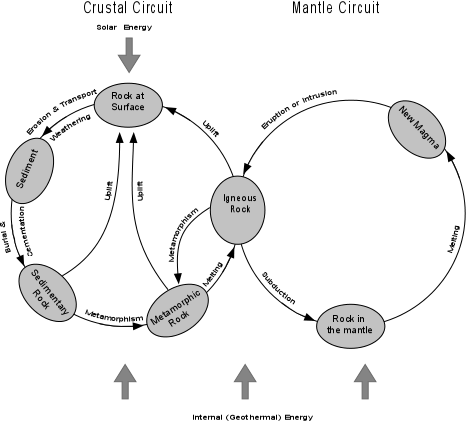
Most surface rocks started out as igneous rocks- rocks produced by crystallization from a liquid. When igneous rocks are exposed at the surface they are subject to weathering (chemical and mechanical processes that reduce rocks to particles). Erosion moves particles into rivers and oceans where they are deposited to become sedimentary rocks. Sedimentary rocks can be buried or pushed to deeper levels in the Earth, where changes in pressure and temperature cause them to become metamorphic rocks. At high temperatures metamorphic rocks may melt to become magmas. Magmas rise to the surface, crystallize to become igneous rocks and the processes starts over.
External Processes Erosion- rocks are broken down (weathered) into small fragments which are then carried by wind, water, ice and gravity. External because erosion operates at the Earth's surface. The energy source for this process is solar and gravitational.
Internal Processes Processes that produce magmas, volcanoes, earthquakes and build mountain ranges. Energy comes from the interior of the Earth, Most from radioactive decay - nuclear energy.
Principle of Uniformitarianism
Processes that are operating during the present are the same processes that have operated in the past. i.e. the present is the key to the past. If we look at processes that occur today, we can infer that the same processes operated in the past.
Problems:
Perhaps a better way of stating the Principle of Uniformitarianism is that the laws of nature have not changed through time. Thus, if we understand the physical and chemical laws of nature, these should govern all processes that have taken place in the past, are taking place in the present, and will take place in the future.
Energy
All processes that occur on or within the Earth require energy. Energy can exist in many different forms:
Heat Transfer
Heat Moves through material by the following modes:
Geothermal Gradient
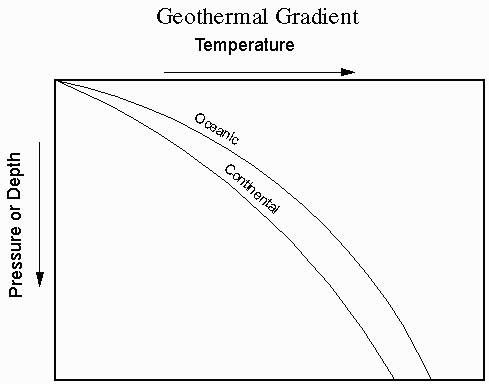
Temperature and pressure increase with depth in the Earth. Near the surface of the Earth the rate of increase in temperature (called the Geothermal Gradient) ranges from 15 to 35oC per kilometer. Temperature at the center of the Earth is about 4500oC
The Earth -- What is it?
The Earth has a radius of about 6371 km, although it is about 22 km larger at equator than at poles.
Internal Structure of the Earth:
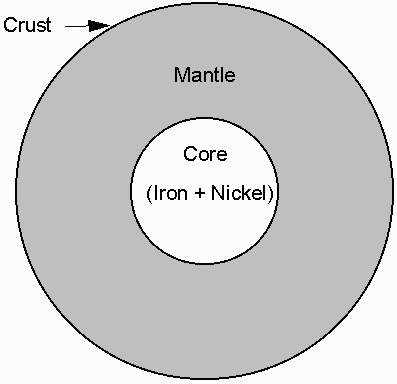
Density, (mass/volume), Temperature, and Pressure increase with depth in the Earth.
Compositional Layering
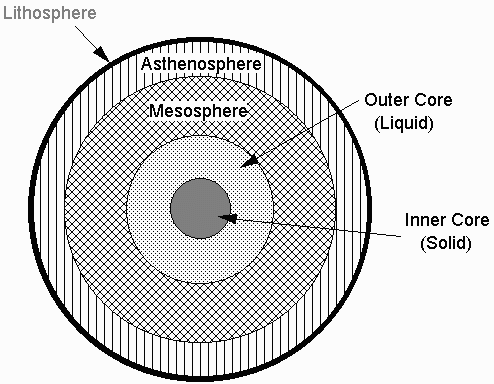
Layers of Differing Physical Properties
All of the above is known from the way seismic (earthquake waves) pass through the Earth as we will discuss later in the course.
Surface Features of the Earth
Oceans cover 71 % of Earth's surface -- average depth 3.7 km.
Land covers remaining surface with average of 0.8 km above sea level
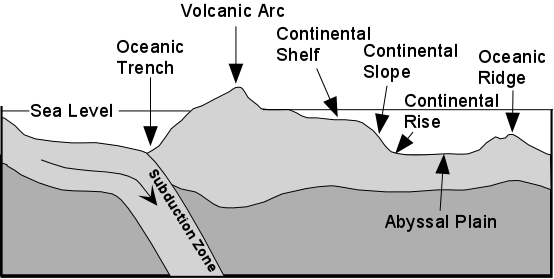
Ocean Basins
Plate Tectonics
Tectonics = movement and deformation of the crust, incorporates
Plates: are lithospheric plates -about 100 km thick, which move around on top of the asthenosphere.
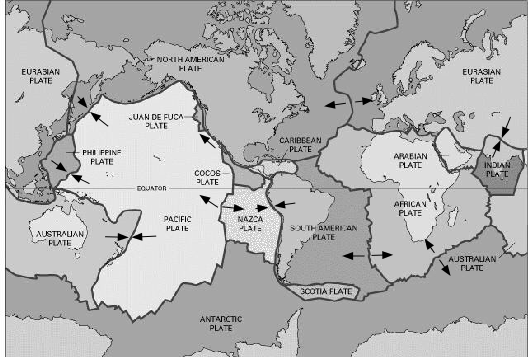
Plate Boundaries
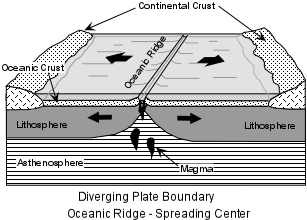
Divergent Boundaries occur at Oceanic Ridges, where new Oceanic lithosphere is formed and moves away from the ridge in opposite directions
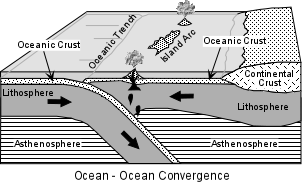
Convergent Boundaries occur where oceanic lithosphere is pushed back into the mantle, marked by oceanic trenches and subduction zones.
Two types are possible -
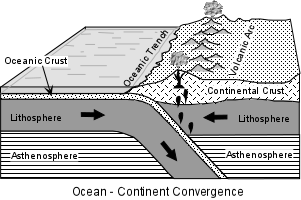
When two plates of oceanic lithosphere converge oceanic lithosphere is subducted beneath oceanic lithosphere. When ocean lithosphere runs into a plate with continental lithosphere, the oceanic lithosphere is subducted beneath the continental lithosphere.
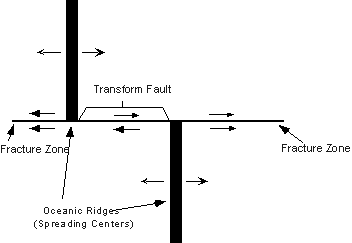
Transform Boundaries occur where two plates slide past one another horizontally. The San Andreas Fault, in California is a transform fault.
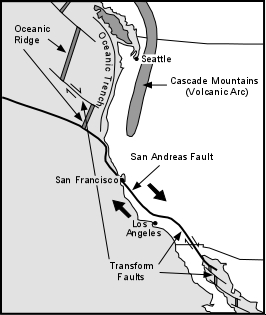

Continental rifting may create a new divergent margin and evolve into an oceanic ridge, such as is occurring in East Africa and between the African Plate and the Arabian Plate.
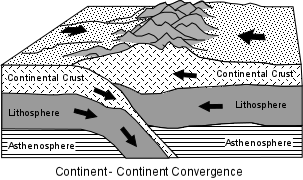
Continental Collisions: may occur at a convergent boundary when plates of continental lithosphere collide to join two plates together, such as has occurred recently where the Indian Plate has collided with the Eurasian Plate to form the Himalaya Mountains.
Plate tectonics explains why earthquakes occur where they do, why volcanoes occur where they do, how mountain ranges form, as well as many other aspects of the Earth. It is such an important theory in understanding how the Earth works.

